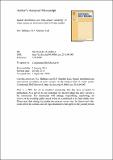Por favor, use este identificador para citar o enlazar a este item:
http://hdl.handle.net/10261/318982COMPARTIR / EXPORTAR:
 SHARE SHARE
 CORE
BASE CORE
BASE
|
|
| Visualizar otros formatos: MARC | Dublin Core | RDF | ORE | MODS | METS | DIDL | DATACITE | |

| Título: | Spatial distribution and intra-annual variability of water masses on the Eastern Gulf of Cadiz seabed |
Autor: | Bellanco, María Jesús; Sánchez-Leal, Ricardo Félix | Palabras clave: | Medio Marino Gulf of Cádiz Centro Oceanográfico de Cádiz Seabed water masses Thermohaline properties Spatial distribution Intra-annual variability |
Fecha de publicación: | 30-sep-2016 | Citación: | Continental Shelf Research, in-press. today: in-press-in-press | Resumen: | This paper presents the spatial distribution and intra-annual variability of seabed hydrography in the Eastern Gulf of Cadiz based on more than 10 years of near-bottom CTD observations. Well-defined water masses and a variety of mixing products are persistently sorted along three bathymetric areas occupying particular depth intervals: (i) inner shelf waters (<60 m depth), with strong coastal and atmospheric influence; (ii) low-salinity Eastern North Atlantic Central Waters (ENACW) related to the Gulf of Cadiz Current (GCC) along the central and outer shelf (between 100 and 250 m depth); and (iii) a range of salinity and temperature flavors associated with the dense Mediterranean Outflow Water (MOW) occupying the deeper grounds. All three are characterized by significant March– November hydrographic differences suggesting an intra-annual variability pattern. After summer heating and stratification of the water column, warm (17.8 °C) and saline (36.26) waters occupy the inner-shelf in November whereas cooler (14.6 °C) and less saline (36.17) waters occur in March as the combined result of the erosion of the seasonal thermocline and intensified continental runoff. Offshore, colder, more saline and hence denser MOW invades the upper slope in March diluting the easternmost tip of a saltier ENACW wedge and nudging its outer rim up onto the shelf. This narrows and constricts the GCC band in winter, while its bottom trace appears to broaden and stretch eastwards in November. More effective MOW-ENACW mixing west of the Strait of Gibraltar driven both by an elevated MOW and a less stratified ENACW could explain the winter salinification of most of the grounds deeper than 250 m. | URI: | http://hdl.handle.net/10261/318982 | DOI: | 10.1016/j.csr.2016.09.001 | ISSN: | 0278-4343 |
| Aparece en las colecciones: | (IEO) Artículos |
Ficheros en este ítem:
| Fichero | Descripción | Tamaño | Formato | |
|---|---|---|---|---|
| Bellanco.SpatialDistribucionWaterMassesGoC.CSR.pdf | 2,35 MB | Adobe PDF |  Visualizar/Abrir |
CORE Recommender
SCOPUSTM
Citations
30
checked on 01-may-2024
WEB OF SCIENCETM
Citations
30
checked on 23-feb-2024
Page view(s)
20
checked on 07-may-2024
Download(s)
26
checked on 07-may-2024
Google ScholarTM
Check
Altmetric
Altmetric
Este item está licenciado bajo una Licencia Creative Commons

